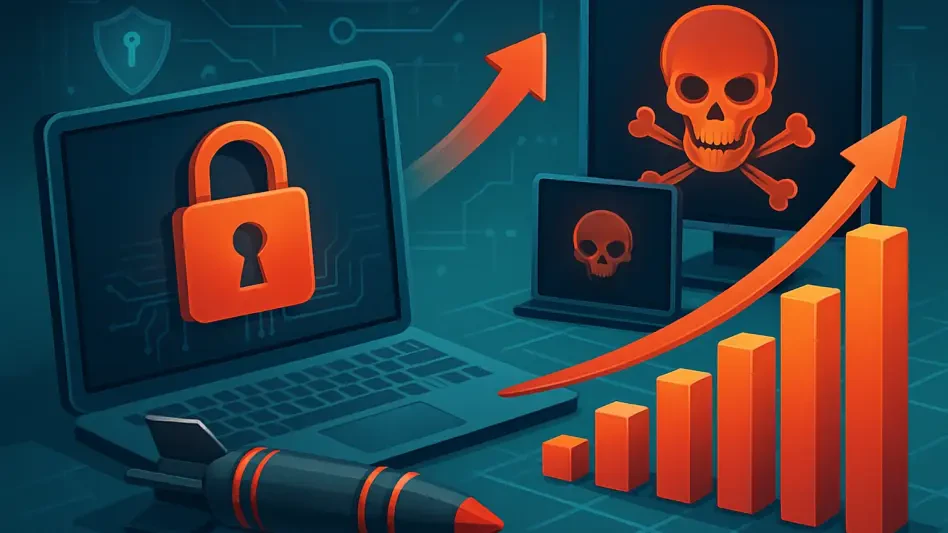In an era where digital landscapes are as contested as physical battlegrounds, the cyber weapons market is witnessing unprecedented growth, driven by the urgent need to combat escalating cyber threats that jeopardize national security and economic stability. With sophisticated attacks like ransomware and state-sponsored intrusions becoming commonplace, the demand for advanced tools to both defend and retaliate in cyberspace has surged dramatically. Projections indicate this market will reach a staggering $25.47 billion by 2032, propelled by a robust compound annual growth rate (CAGR) of 10.21%. This expansion underscores a critical shift in how governments, militaries, and critical infrastructure operators prioritize cybersecurity, investing heavily in technologies ranging from intrusion detection systems to threat intelligence platforms. The stakes have never been higher, as a single breach can disrupt entire economies or compromise a nation’s sovereignty, making the development and deployment of cyber weapons a top global priority in today’s interconnected world.
Escalating Threats Fueling Market Growth
The cyber weapons market is experiencing a boom largely due to the alarming rise in the frequency and complexity of cyber threats targeting diverse sectors. Sophisticated attacks, including supply chain breaches and ransomware, are increasingly aimed at government systems, energy grids, and financial institutions, creating an urgent need for robust defensive and offensive capabilities. This growing menace has prompted nations to allocate substantial portions of their defense budgets to cybersecurity, focusing on modernizing infrastructure to withstand and counter these digital assaults. Beyond mere protection, the ability to retaliate or deter through advanced cyber tools has become a strategic imperative, as adversaries leverage cyberspace to undermine stability. The persistent evolution of attack methods ensures that staying ahead requires constant innovation, pushing market players to develop solutions that address both current and emerging risks with precision and speed.
Another critical factor driving this market is the expanding attack surface created by the integration of information technology (IT) and operational technology (OT) across industries like healthcare, transportation, and manufacturing. As these systems become more interconnected to enhance efficiency, they also become more vulnerable, offering cybercriminals new entry points to exploit. Tailored cyber weapons are now essential to safeguard these critical systems, ensuring they are shielded from disruptions that could have cascading effects on public safety and economic health. Regulatory mandates are also playing a pivotal role, with governments worldwide enforcing stricter standards for continuous monitoring and rapid incident response. These policies are not just protective measures but also catalysts for market expansion, compelling organizations to invest in cutting-edge technologies to meet compliance requirements and maintain operational integrity in an increasingly hostile digital environment.
Technological Advancements Redefining Cyber Defense
At the core of the cyber weapons market’s evolution lies a wave of technological innovation, with artificial intelligence (AI) and machine learning (ML) emerging as transformative forces in combating digital threats. These technologies enable real-time threat detection by analyzing vast datasets to identify anomalies and potential breaches before they escalate into full-scale attacks. Automated response mechanisms powered by AI further reduce reaction times, allowing systems to neutralize risks with minimal human intervention. This shift toward intelligent, predictive analytics marks a significant departure from traditional, reactive cybersecurity approaches, equipping organizations with tools to anticipate and thwart sophisticated attacks. As cyber adversaries grow more cunning, the ability to leverage AI for preemptive defense is becoming a cornerstone of modern cyber warfare strategies, driving substantial investment and research in this domain.
Beyond AI, the adoption of hybrid deployment models is reshaping how cyber weapons are implemented, offering a blend of on-premises, cloud-based, and edge computing solutions to maximize flexibility and resilience. This approach ensures that organizations can scale their defenses in response to dynamic threats while maintaining operational continuity across diverse environments. Additionally, integrated threat intelligence platforms are gaining prominence, consolidating data from multiple sources to provide actionable insights and predictive capabilities. These platforms empower entities to stay ahead of attackers by identifying patterns and vulnerabilities before they are exploited. The growing use of cyber ranges and simulation environments also reflects a proactive stance, enabling training and testing under realistic conditions to refine strategies. Together, these advancements signify a market focused on adaptability and foresight, poised to tackle the challenges of an ever-shifting digital battlefield.
Global Landscape and Regional Powerhouses
Regionally, North America dominates the cyber weapons market, underpinned by its advanced technological infrastructure and significant cybersecurity budgets that outpace other areas. The presence of leading industry players, coupled with strong national policies mandating cyber readiness, solidifies its position as a global leader in this space. Collaborative efforts with allies and substantial investments in research and development further enhance its capabilities, ensuring that North America remains at the forefront of both defensive and offensive cyber strategies. This dominance is not just a reflection of financial commitment but also of a strategic focus on maintaining digital sovereignty in an era where cyber threats can undermine traditional military advantages, making cybersecurity a critical component of national defense frameworks.
Meanwhile, Asia-Pacific is rapidly emerging as a high-growth hotspot, with nations like China, India, and Japan channeling significant resources into cyber warfare technologies amid accelerating digitalization. The region’s focus on protecting burgeoning digital infrastructures, particularly in sectors like telecommunications and finance, drives this surge, as does the increasing recognition of cyberspace as a domain of geopolitical competition. Europe, too, is a key player, with growth fueled by stringent regulatory frameworks and partnerships through organizations like NATO, which prioritize collective cyber defense. Even regions with smaller market shares, such as Latin America and the Middle East, are stepping up, modernizing cybersecurity in critical industries like oil and telecommunications. This global disparity in investment and infrastructure highlights varying levels of readiness, yet the universal need for cyber protection unites all regions in a shared mission to secure digital frontiers.
Barriers to Seamless Market Expansion
Despite the optimistic growth trajectory, the cyber weapons market faces formidable challenges that could impede progress if left unaddressed. Ethical and legal concerns surrounding the development and use of offensive cyber tools are at the forefront, as their deployment raises complex questions about international norms and potential misuse. Such issues could lead to heightened scrutiny and stricter regulations, slowing the pace of adoption and innovation in certain jurisdictions. The risk of escalation in cyberspace, where retaliatory actions could spiral into broader conflicts, adds another layer of complexity, necessitating careful policy considerations. Balancing the need for robust defense with the imperative to avoid unintended consequences remains a delicate task, one that could shape the market’s future direction as global stakeholders grapple with defining acceptable boundaries.
Another pressing obstacle is the chronic shortage of skilled professionals capable of designing, implementing, and managing these advanced systems, creating a significant bottleneck for market scalability. Integration challenges also loom large, particularly when aligning cutting-edge cyber weapons with outdated legacy systems that are still prevalent in many organizations. Budget constraints and lengthy procurement cycles, especially in the public sector, further complicate adoption, delaying the deployment of critical tools. Additionally, the rapid evolution of cyber threats demands continuous updates and enhancements, driving up development and maintenance costs that strain resources. These barriers collectively underscore the need for strategic solutions, from workforce development initiatives to streamlined acquisition processes, to ensure that the market can sustain its growth momentum without being derailed by operational or ethical pitfalls.
Pathways to Future Opportunities
Looking ahead, the cyber weapons market is brimming with opportunities that could further accelerate its expansion if harnessed effectively. AI-powered automation and orchestration stand out as key areas, offering the potential to enhance threat mitigation efficiency by enabling faster, more accurate responses to attacks. These technologies can alleviate some of the burden caused by talent shortages, allowing systems to operate with greater autonomy while maintaining high levels of security. The development of tailored solutions for emerging threats, such as those targeting Internet of Things (IoT) devices or cloud-native environments, also represents a promising niche. By addressing specific vulnerabilities in these rapidly growing areas, market players can carve out specialized roles, meeting the unique needs of diverse sectors and reinforcing the overall cybersecurity ecosystem.
Collaboration presents another vital avenue for growth, as partnerships between defense agencies, private cybersecurity firms, and academic institutions can drive innovation and establish best practices. Such cross-sector alliances facilitate the sharing of knowledge and resources, fostering the development of cutting-edge tools and strategies. The rise of cyber insurance markets is also expected to spur demand for defensive systems and risk assessment technologies, as organizations seek to mitigate financial exposure to digital threats. Furthermore, the increasing emphasis on cyber ranges and training programs signals a growing market for platforms that enhance workforce readiness and strategic preparedness. Capitalizing on these opportunities will be crucial for stakeholders aiming to lead in this dynamic space, ensuring that the market not only grows in value but also in its capacity to safeguard global digital infrastructure against an ever-evolving array of challenges.
Reflecting on a Digitally Fortified Horizon
Reflecting on the trajectory of the cyber weapons market, it becomes evident that this sector has solidified its role as a cornerstone of modern defense and security strategies by addressing the relentless surge of sophisticated cyber threats. The remarkable projection of reaching $25.47 billion by 2032, underpinned by a steady 10.21% CAGR, highlights the global commitment to fortifying digital domains through substantial investments and regulatory support. Technological strides, particularly in AI and hybrid models, have redefined how threats are countered, while regional leaders like North America and fast-rising Asia-Pacific showcase the diverse yet unified push for cyber resilience. Challenges such as ethical dilemmas and talent gaps pose hurdles, yet the market responds with innovative pathways like automation and collaboration. Moving forward, stakeholders should prioritize workforce development, international dialogue on cyber norms, and investment in niche solutions for emerging risks. These steps will ensure that the market continues to evolve as a vital shield against digital adversaries, securing a safer future for nations and industries alike.








